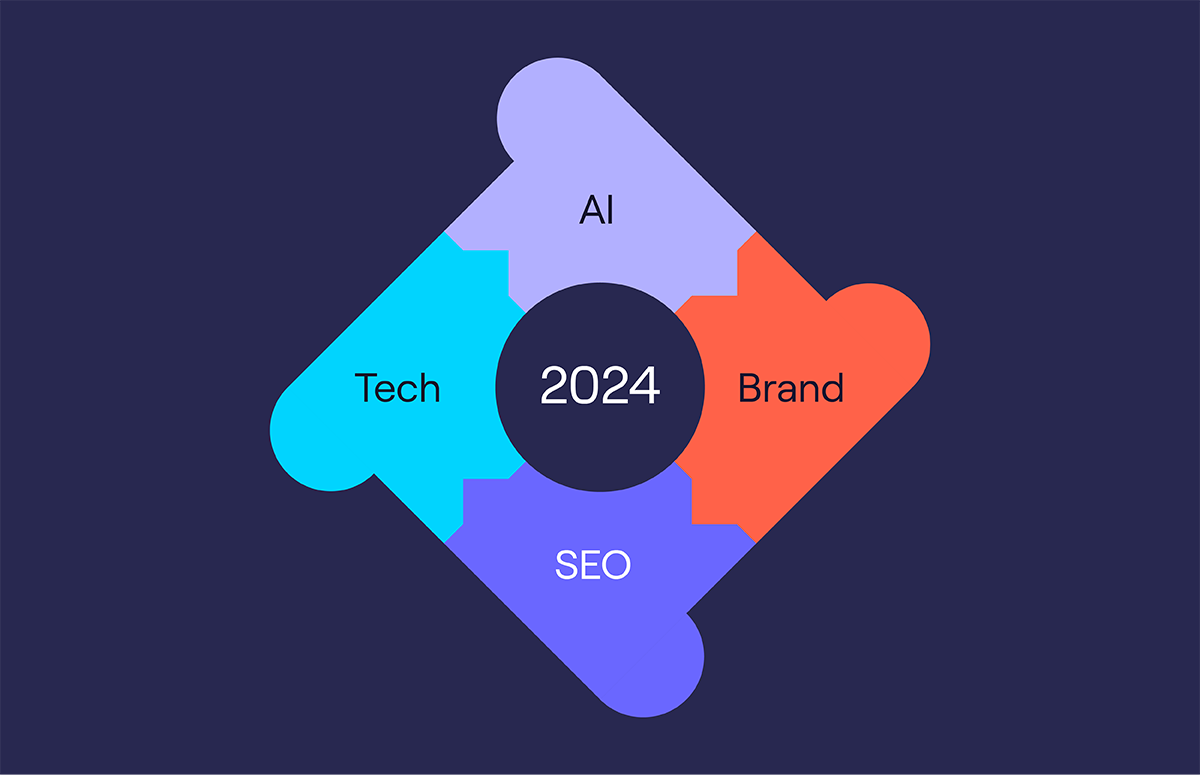The Beginner's Guide to PPC
What's on this page:
This is a guest article by Sam Warren, the Director of Marketing at RankPay - a top-rated SEO service that helps hundreds of small and mid-market businesses grow their online presence.
In case you’ve been living under a rock for the past few decades, PPC (Pay-Per-Click) advertising is a seriously effective way to get your business digital exposure quickly.
While it may seem conceptually simple, you can easily spend over your budget without doing some proper leg work and research.
Before you start creating a PPC campaign, you should completely familiarise yourself with what you’re getting into.
In this beginner’s guide to PPC, I’ll walk you through everything you need to know to get up and running with your own PPC campaign.
That way, you’ll launch PPC ads correctly and effectively, maximise traffic, and improve your B2B lead generation. And the more site visits you get, the more sales and revenue you generate!
What is PPC?
PPC advertising is an online advertising model where advertisers pay a fee whenever an internet user clicks on their ads. But what makes PPC ads different from organic search results?
Unlike search results that appear organically, PPC ads aren't free. And while they look similar to organic listings, there are some notable differences.
An image is worth a thousand words as they say. So I took a screenshot of a standard google search to illustrate the difference between the two.
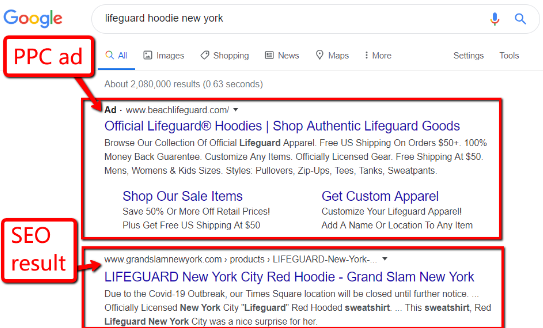
As you can see, there is an ad listed first (there can be up to 4 shown here). Subsequently, you’ll see the organic search results.
Of course, many search result pages will include maps, news stories, or featured snippets and answer boxes. But those are topics for another day.
Why use PPC?
While both SEO and PPC are about making a great first impression in search engine result pages, they actually function quite differently.
As a marketing channel, paid advertising comes with unique benefits (and costs). Let’s take a closer look.
1 - A quick increase in visibility
Fact: PPC advertising produces an average 80% increase in brand awareness.
As you can probably infer, this means that paid advertising is a fantastic way to introduce your brand to new audiences.
So if you want to expand your brand awareness and make inroads with new markets, PPC is one of the fastest and most efficient ways to do so.
Good things come to those who wait, sure. But waiting can also mean you’re missing out on promising opportunities and business.
2 - Hyper-targeted audience
Search engine optimisation does indeed allow you the opportunity to target specific audiences, but it is less granular than PPC by nature. After all, you can literally set demographic data that controls directly who your PPC ads are shown to.
That’s definitely not the case with SEO.
When properly leveraged, the specificity of targeting provided by PPC platforms allows sponsors to hone in on a specific ROI. Targeting systems also allow ad personalisation to be a prominent feature.
The more personalised your approach is, the more effective it will be. That’s because personalised ads will allow you to reach the right people, at the right time, with the right message.
Believe it or not, you can target specific ages, genders, geographic locations. You can even include custom parameters like interests and attitudes!
3 - Better measurement of results
Can’t tell if your online marketing campaigns are working? Don’t know if your conversion rates are going up?
If you’re a B2B marketer, this could spell trouble. In fact, 42% of B2B marketers state that the absence of quality B2B data is a big challenge to their lead generation efforts.
Don’t worry, though. PPC advertising (when properly set up) will provide very clear data.
To be fair, there’s no reason you can’t accomplish this with your SEO efforts as well via free tools like Google Analytics. But even without GA, Google Ads (or any major PPC platform) will have very strong and customisable data right in your administrative panel without any set up required.
To find out for yourself, why not create an advertising campaign on Facebook? Once you’re ready with a campaign, you can access a dashboard where you can monitor what’s going on with your campaign.
Refer to the image below. As you can see, for every advertising campaign, you can measure results such as your ad’s reach, impressions, the amount spent, and more.

(Source)
How does PPC work?
In this beginner’s guide, we’ll start simple. We’ll start off where most marketers take their first steps into PPC advertising: Google Ads.
Step 1 - Sign up for a Google account
Already have an existing account? Then simply sign in to that account to be done with this step.

Step 2 - Get started with Google Ads
Go to the homepage of Google Ads and click Get started.
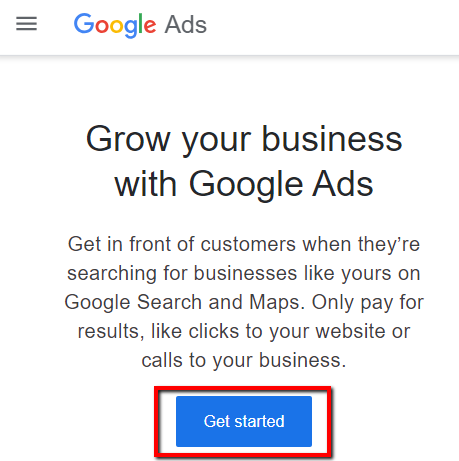
Google will then redirect you to a form where you need to provide details for a new campaign. To kick off a new campaign with Google PPC, enter your business name and business website.
Click NEXT once you’re finished.
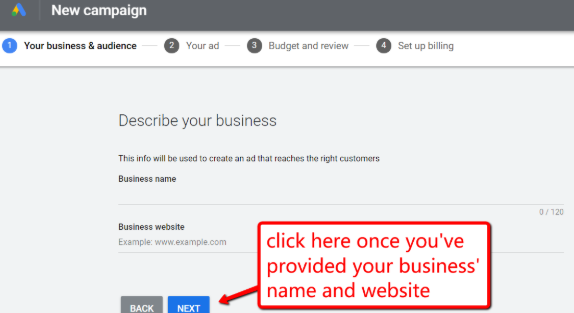
Step 3 - Fill out the rest of the form
Then finish filling out the rest of the form. This means completing these sections:
- Your business & audience - This refers to information about your customers, potential audience size, and where you want your ad to appear.
- Your ad - Here, you’ll write your ad copy.
- Budget & review - This is where you’ll set your ad budget and review your campaign settings.
- Set up billing - This is where you’ll provide billing information.

Once you’re set, tick the box to say that you agree to Google’s terms and conditions. But of course, you should only do this if you fully agree with what you’re signing up for.
So make sure to read the agreement (Advertising Program Terms) first.
Then hit SUBMIT to launch your campaign and start reaching more people.
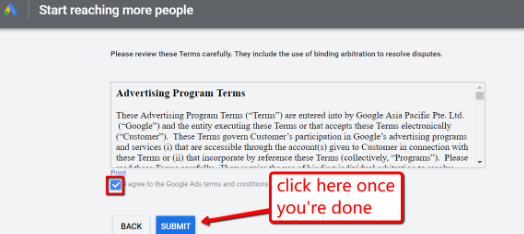
How to optimise your PPC campaign
Now that you have your campaign setup, it’s time to get setup for management and optimisation of your ads.
Targeting the right audience is a powerful and essential approach. When you’re reaching the right audience, you’re saving resources -- both yours and your potential customers’ - by not beating around the bush.
But more than just targeting the right audience, you should also know what’s important to your target audience and what they’re searching for. Knowing your Ideal Customer Profile will help you here.
Optimising your campaign for generating the highest clicks with the lowest spend is an obvious goal for many B2B marketers. But, there are a variety of factors involved in this such as term selection, ad copy, and others.
More importantly, you have to consider their conversion rates to help you determine your ad budget. The click-through rate of ads depends on your industry and the goal you want to achieve with them.
WordStream released a study that shows the average CTR of each industry, among other factors.
But instead of worrying about these things, head on over to Peer Analytics’ Free PPC Budget Calculator.
By entering your keywords, the tool shows you the estimated daily and monthly spend on your ads. This way, you remove the guesswork so you can develop your campaign based on these figures.
Aside from these things, here’s what else you can do to optimise your PPC campaign:
- Market to small ad groups - Focus on a specific group of leads using ad text that appeals to them. This will keep your campaigns organised and effective.
- Exclude negative keywords - Perform keyword research to identify and exclude irrelevant keywords. Your goal is to prevent them from showing up in results for searchers who are not interested in what you’re selling.
- Use compelling CTAs - When possible, be sure to include clear and concise calls to action to drive visitors to a desired place.
Last but not least, you’ll want to monitor and iterate (potentially) all aspects of your new PPC campaign/s.
Make adjustments routinely. Create negative keyword lists if your keyword targeting isn’t specific enough. Run A/B tests on ad copy to drive greater click through rates.
Adjust your bid strategy or actual bids in order to lower CPC’s and improve your ROI.
The sky is the limit. But don’t just set up a campaign and let it run itself. PPC campaigns require maintenance and ongoing optimisations. So no excuses!
Conclusion
Overall, the value of PPC advertising should be pretty clear.
Many business owners will simply not have the time to run campaigns even if they know it’s an important step for them to take.
If after reading this guide, you find yourself in that boat, we’ve been managing PPC campaigns for over 13 years and would be more than happy to help. So feel free to visit our site and learn more about how we leverage Google Ads and other platforms to our clients benefit.
Remember, no matter which route you take, it’s important to keep your eye on the ball with PPC campaigns.
Stay up to date with the most recent PPC best practices. Monitor your results. And make improvements as you go along.
Get more B2B marketing insights
Here at Cognism, we’ve recently published an eBook featuring articles from a plethora of B2B marketing influencers!
Leverage the data driven marketing knowledge of some of the best minds working in B2B and SaaS today. Our 'no fluff guide' to inbound marketing contains insights from marketers at Sales Hacker, Vidyard, G2, SaaStock and more.
Click the image below to get your free copy!



